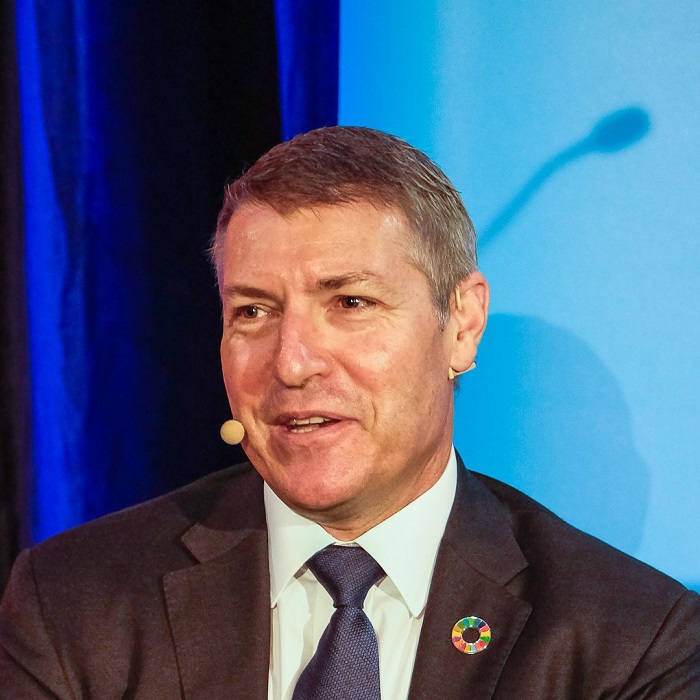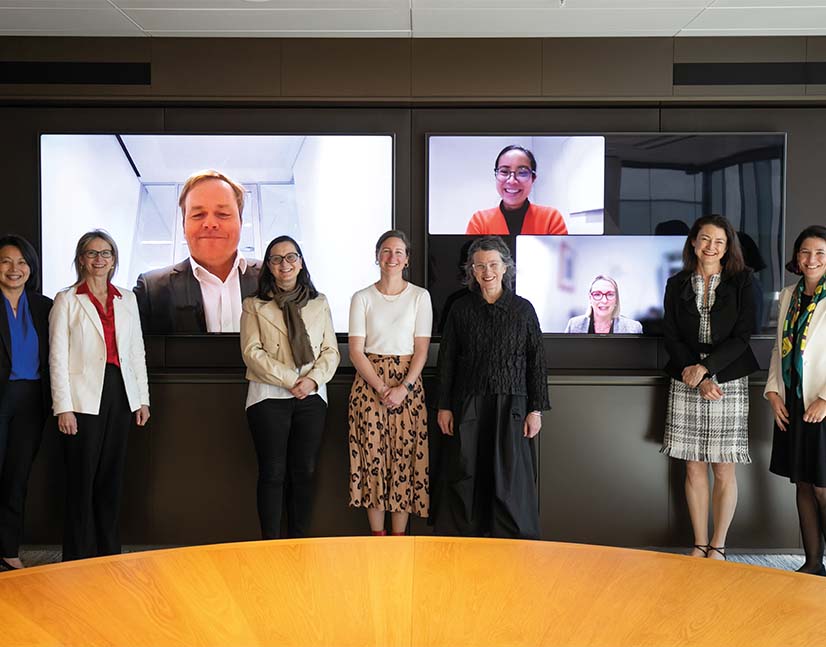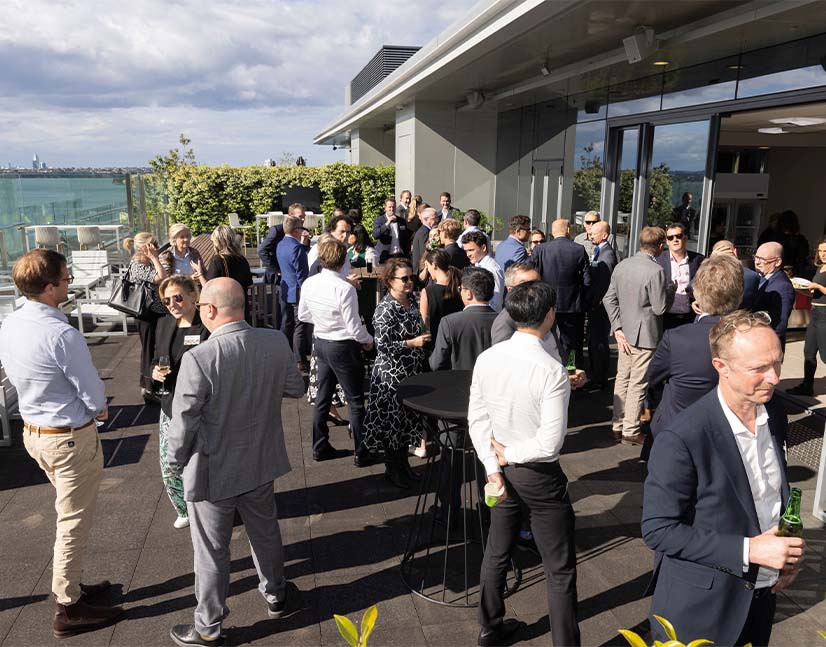
The next generation of sustainable finance challenges
In late September, ANZ, KangaNews Sustainable Finance and Pollination Group brought together prominent sustainability investors and corporate issuers to discuss emerging challenges in sustainable finance and how to solve them. Reporting standards, greenwashing risk, natural capital and biodiversity, and the danger of being overwhelmed as more areas are added to the sustainability mix top the list of challenging issues.
SUSTAINABILITY MOTIVATION
Swiss It is worth setting the scene for this discussion by hearing how participants believe the sustainable finance universe is evolving. In particular, what do they believe will be high on the sustainability agenda in one, three, and 10 years’ time?
BRENNAN One of the key challenges for us – and I’m sure many corporates would share this challenge – is understanding what the financial implications of climate change will be for our organisation. It is a very complex area and there are many ways to go about it. In fact, every organisation seems to be working out its own way of addressing this particular challenge. It will certainly be a major focus for us this financial year.
The longer-burn issue for an organisation like Transurban is materials: embodied carbon and low-carbon materials. There has been some great progress in this area but we are still in the very early stages of development, relatively.
BARKER Global reporting standards is our next focus and it is very much the strategic planning piece on climate change that is critical for our business. We are working to ensure we are embedding climate considerations into strategic planning. Then we move to what the financial implications look like over the medium-to-long term. It is challenging for us to work through and determine how we will disclose this type of information externally.
The other piece is resources. The circular economy will become much more critical in the sense of how it links to climate change, specifically what role we can play in reducing resource use – including recycling and reducing waste to landfill, which contributes to greenhouse gas emissions.
For instance, as part of our procurement of EV [electric vehicle] charging infrastructure, we can consider raw materials – for instance how we can reduce resource use during the manufacturing and distribution process, and divert waste away from landfill either through reuse or recycling of materials.
MANTELL We are facing similar issues, albeit on a very different scale from the likes of Transurban and Ampol. Celsus is responsible for the Royal Adelaide Hospital (RAH). Last year, we procured the largest healthcare sector green and social sustainability-linked loan (SLL) globally, at A$2.2 billion (US$1.4 billion). Our task was then to develop a really good strategic framework.
We have an ESG [environmental, social and governance] framework that supports our policies. The board endorsed this earlier this year. At the end of August, we released our first ESG report for the financiers of the loan, which outlines what we have done to date. The next step – which we are working on now – is to work with our key subcontractors, Central Adelaide Local Health Network (CALHN) and South Australia Health, to integrate a green and social lens across everything we do. The idea here is that ESG is not something that sits on the side – because if it does, we will never get time to focus on it. Until ESG is embedded into everything we do, we won’t move forward. We have a contract until 2046, with net zero targets prior to this. The plan now is to roll out ESG through the entire concession of our contract.
WARD Right now, climate commitments and sector sensitivities are dominating client conversations. In the next year, the focus will be on measuring and mapping decarbonisation pathways, including proxying for scopethree emissions given the low level of reported and estimated data. Also on the agenda in the short term will be solving for government and government-related bonds, and helping clients with considerations about exclusions.
Out to three years, I expect the investor conversation will refocus on other areas of sustainability risk and opportunity – that is beyond the, warranted, current domination of climate. I also hope to see more government emissions and decarbonisation roadmaps.
Going out to 10 years, we will have moved through interim measures for net zero targets and a group of companies will have experienced stranded financing risk and therefore will have been left behind. My job as an investor now, and strategising beyond the next decade, is to be positioning portfolios ahead of these risks so returns are protected and opportunities can be seized.
TURNER Working in ESG is like working with layers of an onion – we do some work on climate change or biodiversity then we uncover a whole lot more.
On climate change, a lot of commitments have been made across the investment community on net zero by 2050. But more work is needed to translate these into what needs to happen between now and 2030 to meet the long-term target. Right now, we are looking at the immediate things we need to be doing for those targets to be met. We are doing this by drilling into different sectors and companies we invest in. Another area we have been doing a lot of work on is natural capital and biodiversity. This is an important area in its own right, notwithstanding we understand there is a nexus between biodiversity and climate risk.
I think a lot of investors are still struggling with understanding the concept and what it means for investors and the companies they invest in. There are several exciting global developments in this area – such as the TNFD [Task Force on Nature-related Financial Disclosures] and other tools. But investors are still at a very early stage of understanding.
We also continue to focus on modern slavery and human rights. This is an ongoing concern. The Global Estimates of Modern Slavery report released by the International Labour Organization, Walk Free and the International Organization for Migration, in mid-September, revealed that the estimated number of people in modern slavery has risen by approximately 10 million in the last five years, to almost 50 million. This does not take into account the effect of the Russia-Ukraine conflict, which we believe will have created a hotspot for modern slavery. This is all happening at a time when we have an SDG [UN Sustainable Development Goals] target of eliminating modern slavery by 2030.
The last area I’d mention is diversity – and thinking about how to expand this beyond gender. The wider concept of diversity can become much more difficult to measure, understand and engage with companies on.
CHRYSTAL I have a wish list. One thing we have found in talking to a wide range of companies is that everyone is at a different stage in their ESG journey. Some are very advanced with articulated targets while others do not have a transition plan at all. What we hope for in the medium term is for every company to have a transition plan and for more standardisation of data so we can understand better where different companies sit.
We are very focused on engagement with companies because, as investors, we need to understand where to allocate capital not just today but into the future. This means we need to look forward, assess the challenges and try to work out which companies are best placed to face those challenges.
Longer term, I agree that 2030 will be an interesting point. Hopefully, many entities will have reached the targets they have set – but what if they don’t? What concerns me is that the timeline between 2030 and 2050 will be really crunched if we don’t hit 2030 targets.
MANDATORY TCFD
Swiss There is growing talk of Australia getting a mandatory reporting regime in line with the Task Force on Climate-related Financial Disclosures (TCFD) (see box below). Would this help with some of the challenges?
WARD Whether or not we get a mandatory climaterisk reporting regime in Australia, our clients are making it mandatory. What we are looking for is international harmonisation so we can compare, for example, a local bank bond to a European utility bond when we are weighing up investment opportunities for a fund.
DANN A mandatory regime can be expected in Australia. But while some entities have a lack of transition pathways and planning, it is also true that TCFD reporting is already reasonably advanced. By and large, it is occurring as a natural evolution in the sustainable finance arena.
Some of this is related to the focus we have discussed on the calls for clarity, detail and standardisation – to the extent it is possible. Now the focus is on the specifics, from companies as well as investors. Longer-term targets have been set but how will they be achieved? What actions need to be taken and in what time frame? It is not enough to keep it high level any more and investors know the devil is in the detail.
I agree that once we start working on one area of ESG it usually creates an opportunity to look into something else in more depth. I can understand why this might seem like anever-ending journey. But I also think we will get to a place where everyone feels more comfortable because of things like standardised reporting.
WHITTON From conversations with participants across industry and government we know mandatory disclosure is a major area of focus for policymakers and has significant support from sections of industry.
Historically, when regulators in Australia have engagedon climate-related financial disclosure reporting it has often been with a tone that implies entities should be taking account of these risks anyway. In other words, regulators have often suggested material risks should be part of regular reporting and that, while companies should consider TCFD, it was not believed that this presented a massive change to their existing overall responsibilities to report material risks.
This leads to an interesting question for Australia: when we get to mandatory disclosure, how specific and how prescriptive should it be? Will it be something like ‘remember you are meant to be disclosing risks, and TCFD is a good model for doing so’ – which has been the commentary to date? Or will it be more like what the New Zealand XRB [External Reporting Board] has done, which is a very strong set of specifications regarding the types of details entities have to disclose?
We are keeping an eye two other factors regarding with how much specificity Australian companies will be asked to disclose. One of these is the TCFD itself – which continues to be updated. In the standard, targets that used to be a ‘nice to have’ are now a ‘must have’.
The other thing to be aware of is the UNHLEG [UN High-level Expert Group on Net Zero Commitments of Non- State Entities]. This group is tasked with forming a view on what is sufficient for nongovernmental net zero targets rather than getting sufficient disclosure of risk. Its interest is in getting net zero targets and transition plans that are sufficient to address climate change.
We may end up with a global view forming about what is a sufficient net zero target or set of reporting that is based on different norms from the ones we are used to seeing in this market.
“If a sustainability bond launch is the first time an issuer mentions or publishes anything about its green or social practices and beliefs, we will question its motivations and likely sit out of the deal. Likewise, if a sustainability-linked bond’s targets are not addressing an issuer’s key ESG risk, we see greenwashing risk.”
Swiss So mandatory TCFD reporting could take quite a light-touch approach or it could be very prescriptive. At the same time, issuers say they want to provide meaningful and credible data but it is not always available or comparable. How are investors dealing with these challenges and what are their expectations regarding disclosure?
TURNER First Sentier Investors has reported under TCFD on a voluntary basis since the recommendations were originally released. However, this year we had to report on a mandatory basis to comply with a Hong Kong Securities and Futures Commission circular on climate risk, which is quite prescriptive. Having had the experience of moving from voluntary to mandatory reporting, I can say there is a marked difference between the two.
It was not without challenges, but looking at it positively the real benefit is how the entire organisation had to get involved in the process. With prescriptive, mandatory reporting, we had to take a whole-of-business approach and, as a result, there is much greater awareness within First Sentier regarding climate risks and how they are managed.
The trade-off between comparability and credibility of data we have spoken about today is a real consideration. It will be really powerful when we start to get more comparable and credible data. Even with emissions data, which is among the most evolved, disclosure is patchy globally and we sometimes have to rely on estimates. Other times it is disclosed but with so many limitations it is hard to make an investment decision based on the information given.
It is true that it was probably never intended that investment decisions would be made based on estimated emissions data. But we have made net zero commitments with emissions intensity reduction targets, which means we are having to make decisions based on the information we have.
CHRYSTAL I’m looking at all of this with a very concerned eye. It is a concern because there is so much to be aware of – we have to make sure we do not miss anything major while, as we have heard, corporate resources are stretched.
Mandatory reporting could help. But it will take even more of our resources to do so. With some ESG issues, the way we deal with lack of data is to call issuers in our portfolio and ask them questions, like whether they can disclose scope-one and scope-two emissions or whether they have a net zero plan and, if so, what steps they are taking to meet it. Then we call them all again in a couple of months to check on progress. Building a database in this way is extremely time consuming and it takes a lot of resources.
Layering mandatory TCFD reporting on top of this is a lot of work. This is why standardisation of data is crucial: if there are standards it will be much easier to do reporting well.
WARD Across our investors, what is sensitive to one is not a concern for another. So my harmonisation dreams seem implausible. A few of the challenges from an investor perspective are dealing with data deficiencies, integrity and consistency, and incomplete frameworks – such as treatment of derivatives and sovereigns – at the same time as reporting expectations are expanding, for instance to scope-three emissions.
“Suggestions about greenwashing are increasingly becoming a risk to which we are alert, to make sure what we say to the market is factual, credible and backed up by evidence. We are increasingly getting broad review including legal opinions on content before it goes out. This will be common practice from now on.”
Incoming taxonomy
In a world where comparable data is crucial, a jurisdiction-wide framework on which to base climate risk calculations – a taxonomy of climate-related activities – could be a gamechanger. There is optimism about an Australian taxonomy but it will not be a panacea.
WHITTON I am a member of the TAG [technical advisory group] for the taxonomy being developed by the Australian Sustainable Finance Institute. But my take on taxonomies and what they can be used for is a little controversial.
There is a strong drive toward standardisation of information at the intersection of sustainability and finance. This has not always been the case. When we first had discussions about TCFD [Task Force on Climate-related Financial Disclosures], much of the narrative was along the lines of leaving everyone to do their own style of reporting in the hope that best practice would develop over time. There was a lot of support for flexibility.
What I am hearing today, which matches what I have heard from other people in the industry, is that users are increasingly asking for clear guidelines and standards because this will clarify their work and reduce their workload.
It is true that a taxonomy can play a role in this. But I think a taxonomy will only be really useful for certain parts of sustainable finance. It is great for debt issuance, for example. But a taxonomy is not anywhere near as useful for some of the other challenges we are trying to deal with in the intersection of sustainability and finance more broadly.

Engagement between investors and issuers is absolutely paramount, notwithstanding what happens with standards and taxonomies. Issuers should work to understand what investors are looking for. We can’t report on absolutely everything but we want to try to respond as much as we can to particular things specific investors need.
GREENWASHING CONCERNS
Swiss Regulatory action on greenwashing has ramped up this year. With this heightened scrutiny comes more potential reputational risk for issuers and investors. Could this become a brake to the further evolution of the sustainable finance market?
WARD Three things will stunt market evolution. The first is premature setting of net zero targets. There is nothing wrong with aspiration but this can’t just be for marketing – issuers need inputs and plans behind their targets.
The second is if issuers set and forget without thinking about ‘beyond net zero’ once targets have been put in place. The last is incomplete regulatory requirements.
With the first barrier to evolution, the temptation is to eliminate big emitters. But the risk is missing issuers in the portfolio where data is not available and punishing issuers that have genuinely spent time measuring themselves. It also hampers transition financing.
MANTELL When we did our SLL last year we took greenwashing risk under consideration – it was apparent to us that anything we committed to, we had to be able to measure and manage going forward.
I am fairly fortunate that our facility measures almost everything. I also think we had an advantage in going early. A few of our financiers have told me it is likely that criteria will become more advanced as the market develops.
In developing the Celsus green and social finance framework, we ensured we aligned with the SDGs and also undertook an independent third-party validation of our SLL. These criteria continue to be the basis of our ongoing SLL reporting.
One tricky thing was setting the social criteria for the SLL. I am really proud we were able to include green and social criteria – and we have done a lot more reporting, by choice, in the social space than we were required to do. We are working on a reconciliation action plan with CALHN to support local charities and modern slavery reporting.
We also used the SLL as a platform to step into a wider range of ESG-related activities. We have a long way to go, but having board support for our ESG initiatives is an important and positive step.
BARKER Suggestions about greenwashing are increasingly becoming a risk to which we are alert, to make sure what we say to the market is factual, credible and backed up by evidence. We are increasingly getting broad review including legal opinions on content before it goes out. This will be common practice from now on.
Robust external standards we can align with – such as Climate Active, TCFD, Climate Action 100+ and the ISSB [International Sustainability Standards Board] standards – are important, too, as is third-party verification. This creates additional work internally but is a necessary measure to manage greenwashing risk. Meanwhile, there is further work to do to continue to build knowledge of key sustainability principles.
BRENNAN I echo all of this. For this year’s Transurban reporting suite, for example, we added another two layers of verification to the process. It is always interesting to work with marketing and communications departments, which are always looking to tell the story in the best possible way even down to choice of specific words. We have put an extra layer of qualifiers on certain claims, making sure we have physical evidence to back up everything in the report where appropriate.
This is the way reporting will be conducted in future. All these things are coming into play now and there is definitely concern from the legal team in particular. I am not that concerned about greenwashing risk because I know, just by being involved with all the initiatives, that we have everything to back up our claims. We wouldn’t let anything go out that we were not completely confident in.
I also agree about trying to align, wherever appropriate and possible, with robust third-party standards.
“We are at a crunch point with our planet where we need to be really ambitious and brave if we have any hope of avoiding uncontrollable global warming or eliminating modern slavery. The challenge is to find a balance between the need to be brave and the need to avoid greenwashing, without getting completely caught up in red tape.”
Swiss Are investors concerned about greenwashing risk? Some institutional investors have expressed a degree of wariness of putting ESG labels on funds or investment processes in case they – inadvertently – fail to live up to self-enforced guidelines.
CHRYSTAL We read articles about the police raiding Deutsche Bank’s offices because of greenwashing, or hear about Goldman Sachs having to downgrade some of their Article 9 funds into Article 8 funds, and we really never, ever want to be in that situation. It helps a lot when we know what we need to disclose and how to disclose it.
The earlier point about engagement is also relevant – and this does not just apply to issuers but also to our end investors. We have found it is really important to be very transparent about what we are doing – and the limitations of what we are doing.
We tell our investors what we can report on, what data we have and how we are working toward getting more. We have found this to be acceptable by end investors in the same way that we are able to make a fair assessment if a corporate tells us what it is disclosing and what the limitations are. For example, if an investor requires us to report on the carbon intensity of their portfolio and we tell them we can only report on 40-50 per cent of it, this is generally acceptable for now – as long as it is disclosed. This way, if there is a shift in the number they know if it is due to a change in coverage or active management.
This kind of engagement slows things down – but for the better. If we are all more transparent, we will trust issuers a lot more and investors will trust that we are doing the right thing. Once this has been established, it will form the basis for everyone to move forward.
TURNER I am pleased to see greenwashing get called out because there is some irresponsible marketing out there and it has to stop. But I am also really concerned about some of the unintended consequences issuers have spoken about.
We are at a crunch point with our planet where we need to be really ambitious and brave if we have any hope of avoiding uncontrollable global warming or eliminating modern slavery, for example. The challenge is to find a balance between the need to be brave and the need to avoid greenwashing, without getting completely caught up in red tape. I think we will be navigating this for quite some time.
As a fund manager that is regulated in Europe, we have to follow the SFDR [sustainable finance disclosure regulation]. It is exciting to see standardised data coming out for funds, but it will take some time for the market to understand what some of this data tells us – and what it doesn’t.
WARD I think the SFDR experience in Europe, where investors had to classify funds with underdeveloped guidance, provides fuel for the anti-ESG movement. We should not be surprised to see some reclassification and we should not assume that a downgrade indicates greenwashing. But I also look at some sustainability fund and benchmark characteristics and disagree with the philosophies or don’t see substantial differences from our own vanilla funds.
I think about two extremes for greenwashing. At one end are investors or issuers with an intention to misrepresent – perhaps they are more interested in the marketing opportunity or pricing benefit. This is a legal issue.
At the other end is an entity that is genuinely trying to meet but missing a target – maybe because of technology or force majeure. We are more comfortable with the latter but we also keep in mind that both will be a performance risk for investors. We will take more notice of an organisation’s attitude to sustainability.
If a sustainability bond launch is the first time an issuer mentions or publishes anything about its green or social practices and beliefs, we will question its motivations and likely sit out of the deal. If an issuer is arrogant, I will probably pass public comment on the deal. Likewise, if a sustainability-linked bond [SLB]’s targets are not addressing an issuer’s key ESG risk, we see greenwashing risk.
WHITTON It is a difficult space at the moment, particularly for investors. At a high level, we are in a place where consumers and professionals think different things when they hear ‘ESG’. It is easy for an investor to say it takes climate change into account in its decisions and to mean it is trying to control for or interrogate climate risk. At the same time, a consumer of a retail fund could interpret this statement to mean that the fund is not investing in oil and gas companies or it is investing in ways that are aligned with controlling climate change.
One of the most interesting things in the recent ACCC [Australian Competition and Consumer Commission] update on greenwashing is that the commission said it does not matter if a claim is technically correct. If a consumer can – and is likely to – construe it in a way that is incorrect, whoever made the claim is still in the wringer for it. This is really challenging when there is such a wide range of mental models and levels of sophistication among consumers.
We are building language, sophistication and mental models so fast that there will inevitably be wide variety in how stakeholder groups engage with the language being used. We have talked at today’s discussion about the need for transparency. This is particularly important in the context of how material ESG information is being used. For various reasons, we are at a point where this information is being used to make investment decisions across the board – not just in specialist funds.
This is a reflection of the extent to which sustainability and ESG related disclosures have gone from something that was considered soft – that the marketing department could amp up – to something that is now hard.
As a result, we are naturally having to develop a level of discipline that we really have not had to use before. It is understandable that this is a bumpy process. I am very hopeful we will get to a point, supported by disclosure standards as well as the mental models and the best practices we are developing in industry, where we are not facing as much risk on this front as we presently are. But I also think it is not surprising that we are having this huge challenge on greenwashing in the middle of the journey.
DANN I suspect deliberate greenwashing is limited. The problem is there are very different perceptions of what constitutes greenwashing. When we work on sustainable debt deals, our conversations with clients centre first on understanding greenwashing risk and the importance of aiming for best practice. We also encourage borrowers to talk about the negative as well as the positive. This adds authenticity to discussions with bank counterparts and investors.
Let’s not forget that investors are also consistently focused on governance, which will always be at the core of sustainability. Giving a holistic representation of an entity outside a sustainable debt transaction is paramount. This means talking about the areas where they are maybe not doing so well, how issues are dealt with and where performance could be better. This all gives much stronger insight on the strength of governance to capital providers.
The key is encouraging borrowers to aim for best practice. It is fantastic to see when issuers are ambitious within their organisation especially in the context of a sustainable finance transaction. There are differences between product parameters in bonds and loans, even comparing SLBs and SLLs. This brings us back to the point about looking for standardisation and aiming for high-quality transactions that stand up to market scrutiny.
Resourcing data collection and reporting
The more detailed and rigorous climate risk reporting gets, the more businesses and investors will have to invest in data collection, delivery and analysis. This is likely to become a cost of doing business, but it does not mean there are no challenges involved.
BRENNAN This is definitely one of the challenges we are facing. But it is also important to remember that experiences in these areas are very different depending on what ‘end of town’ a business is in. Organisations like Transurban have resources, a sustainability team and a budget, and we are able to employ consultants where necessary to supplement our expertise.
But it is a huge challenge from the middle level of the ASX through to unlisted entities. There is a lot of guidance, but companies always have to interpret and apply it – and there is not really very good practical guidance. This also represents a huge opportunity – for simplification. There needs to be some prioritisation, to make the process practical and meaningful. I hope we might soon see some action along these lines.
It would be great if practical direction, guidance and support becomes available for the middle and smaller end of town. This would enable companies to understand how to go about the process of identifying their climate-related risks and think about practical frameworks to work out the financial implications. They will then be able to give investors and other stakeholders the information they are so desperately craving, and in a consistent format.

An administrative building can get a six-star rating because it doesn’t operate 24/7 and is not running at 140 per cent occupancy like our hospital. It can shut down at 5pm, which is not an option for us. The point is that reporting needs to recognise the difference between industries and it also needs to be really meaningful.
NATURAL CAPITAL AND BIODIVERSITY
Swiss There is a growing volume of talk in sustainable finance circles about natural capital and biodiversity as the next frontier. To what extent are these on the radar for Australian entities?
DANN Biodiversity is absolutely on the agenda. In the realm of sustainable finance and sustainable debt transactions particularly, we are starting to see clients exploring biodiversity targets or projects for sustainability-linked or use-of-proceeds (UOP) transactions, respectively.
The challenges of incorporating biodiversity into a sustainable finance product are similar to what we have seen on the social side. For UOP products, issuers generally do not have enough biodiversity project assets to back a deal. There are also challenges that need to be solved with impact measurement. However, we are seeing biodiversity projects and expenditures in government budgets and the hope is that some of this will filter through into green- and sustainability-bond programmes from government issuers in future.
For sustainability-linked transactions, it is also currently challenging to include biodiversity and natural capital-related targets – for a couple of reasons. First, because it is such a nascent area, which makes it difficult to benchmark the ambition of projects and measure outcomes. Second, SLBs are ideally looking for just one target so the transaction is simple for investors. SLLs ideally have up to three targets.
For most issuers, it would be difficult to choose biodiversity as the one, or one of three, most material topics. In other words, we have explored and will continue to explore biodiversity-related targets where possible as part of a transaction process, but they will often get filtered out and in most instances not make it to the final deal structure.
WHITTON Nature is really complicated because it requires measurement and management across a number of different quantities. With nature and biodiversity, there are often six or seven different natural capitals to be managed; with climate change it is typically a case of managing one.
Having said this, the interesting thing about nature is that it is much closer to many operations than climate change is. We often hear that biodiversity and nature is really challenging – which is absolutely true, particularly on the data front. But the nice thing is that if it is fixed for an asset, the asset owner gets the benefits straight away. This could be resilience benefits or ecosystem services. This doesn’t happen with climate change.
We have already done a number of nature risk assessments for TNFD for listed companies. In some cases, it can be much more achievable than many expect. It involves taking issues industrial companies in particular have often thought about deeply for a very long time and framing them in a way that brings them together and relates them to nature.
We know this is doable. What we are now trying to figure out is how to get this knowledge into industry best practice as quickly as possible – because everyone is trying to move much faster on nature than they did on climate change. We all know climate change, even with the timelines we had, has still been a huge lift to develop best practice and a massive effort to build expertise, teams and reporting processes.
WARD There is some good work being done by groups like Responsible Investment Association Australasia to help investors understand nature and biodiversity risks, and then look to financing nature-positive opportunities. Fund managers also have natural capital offerings and obviously there are private-debt opportunities.
In our bond portfolios, QIC has been mapping nature and biodiversity from the risk side for a while – that is, are there companies in our portfolios that could cause or are causing sensitivities, and if so how do we best address them? We have also been working with government on some private landholder legislation in Queensland. My hope is that some of these projects will be eligible for financing such as semi-government green and sustainable bonds.
Swiss We have heard at this discussion about the resourcing needed when it comes to climate change. Won’t it be a challenge to expect market participants now also to work on nature-related issues?
TURNER Yes. Among investors generally there is still a very low understanding of natural capital, biodiversity, the difference between biodiversity and nature, and what it means for investors and their portfolio companies.
I also agree that biodiversity and nature can get filtered out due to materiality. We see this in the ESG ratings we subscribe to – biodiversity is very rarely a material issue. This is counterintuitive. Thing like water risk are huge issues that are material for many business segments. We just don’t always have the data to make all the connections.
We are really fortunate to have a biodiversity expert in my team. We have an investor working group on this topic and our expert has done a lot within it, breaking down different areas and trying to understand how they are relevant to our investments. We have decided to focus on water risk and deforestation this year and we are thinking about what these mean for us and our investments. In time, we will build out to different areas.
I share the hope that we will have a quicker response with biodiversity and natural capital than we have had with climate. But I fear the reality is that it will be a long journey.
“For most issuers, it would be difficult to choose biodiversity as the one, or one of three, most material topics. We have explored and will continue to explore biodiversity-related targets where possible as part of a transaction process, but they will in most instances not make it to the final deal structure.”
Swiss I’ve heard one of the difficulties with biodiversity and natural capital is how to put a value on it?
TURNER This is one of the challenges but not the only one. The issue here is that nature provides us with all these goods and services free. We exploit them – but we are in a situation where demand is outstripping supply. There is a school of thought that we have to be able to put a value on nature.
Another challenge is targets. In climate change, we are working toward net zero by 2050 so, while we can’t all agree what this means and how to achieve it, at least we have a global goal. We don’t yet have global targets when it comes to nature.
Swiss What about issuers – are Transurban, Ampol and Celsus starting to explore ways to deal with these issues?
MANTELL We will probably look at it in future financing. But, more importantly, we are going to work on it in the short term because it is the right thing to do.
We are a hospital within in a park and a park within a hospital – which makes us different from many other hospitals, which are typically surrounded by concrete. RAH, by contrast, is surrounded by gardens, and has internal and external courtyards, a retention pond and parkland. We also have a number of contractual obligations with the state to preserve the parkland.
We have taken biodiversity really seriously, thinking about what we can do in this space. We have done so before it becomes an obligation in reporting or financing because, as I said, it is the right thing to do.
BRENNAN We are certainly aware of these issues. We define our approach to sustainability through the lens of the SDGs and we have not deemed the “life on land” SDG to be material to our business. Having said this, we have biodiversity impacts for new projects in particular, as well as some ongoing impacts with existing operations.
We have plans on regeneration and enhancing ecosystem values. We are also thinking about biodiversity in relation to materials, such as timber and extraction of other raw materials. But I don’t see us getting fully behind TNFD and producing disclosure on this in the foreseeable future.
BARKER We are in a similar position – biodiversity and natural capital disclosures are not an area of focus for Ampol in the near term. Given the nature of our business, we are devoting our time to other higher priority or higher risk areas right now. This is a complex area for any business to understand. It is very different from when TCFD was released back in 2017. At that time there was a lot of bandwidth for it; I was working at Sydney Airport back then and there was a lot of focus on it by the business.
TNFD is coming at a time when we have so many other things to work on – such as TCFD and global reporting standards – that making time to focus has become a bandwidth issue. I agree that focusing on natural capital and biodiversity is the right thing to do. But it is a real challenge to find the space within the business to think about it and what role we can play going forward.
CHRYSTAL I totally echo these comments. The way we look at climate change and the reason we focus on it first is because, as credit investors, we can immediately see the direct long-term impact of not managing climate change risk – whether it is transition, stranded assets or carbon tax.
Biodiversity and nature is a lot harder to quantify. Instead of looking at it from the top down – like we do with climate change – we are looking at it from a bottom-up perspective. This means we will only look at biodiversity when it is material and relevant.
Swiss Finding the bandwidth to focus on biodiversity and natural capital is clearly a challenge. But can nature be separated from climate change – and if not how can market participants respond?
TURNER We can look at the nexus between climate change and nature in a couple of different ways. The first is that we can’t get to net zero without nature. Also, by not putting a proper value on nature, we are encouraged to outstrip the supply it provides. The more we destroy nature, the worse the impacts of climate change will be – think of how forests act as carbon sinks, for example. The worse the impacts of climate change are, the more we will destroy nature, and our biodiversity specifically.
The two are so interlinked – we can’t think about them separately and we need to think about them more holistically. I know it is not easy, but we have to if we want to avoid the worst impacts of climate change.
WHITTON We often talk about climate change as being the primary impact because it moves or destroys natural capitals, which are the infrastructure that provides us with all the ecosystem services we need to run our businesses and live our lives.
For example, climate change moves rainfall to different times of the year or to different parts of a continent, which can mean an agriculture asset isn’t worth what we thought it was before.
We work a lot on the intersection of nature and climate change. Interestingly, many of the solutions for climate change come from nature. For example, one of the challenges on the horizon for climate change we haven’t spoken about today is adaptation.
The climatic events this summer, in the northern and southern hemispheres, have been extraordinary. When we get into adaptation for events like these, the solutions are things like regenerating mangrove wetlands to give an appropriate buffer from the storm surges that are becoming increasingly troublesome, or making sure there is sufficient diversity in plantations on mine sites so all the dirt doesn’t jump into the mine pits each time there is heavier rainfall than usual.
There is an interconnection between nature and climate change that we bump into at every corner of the conversation. But I agree with earlier comments that we need to be careful of the danger of overwhelming.
Historically, when we dealt with climate change it was relatively simple to ask companies to think about profit and shareholder results when asking them to consider the risks. But this approach doesn’t work as well for managing all our other natural capitals.
Despite their experience, corporate decision makers do not yet have the mental models to go from dealing with and optimising for one thing to seven or eight things at a time, all of which are completely interconnected.
We have to be judicious in how we build our best practice and mental models to get from having to optimise for one thing to having to optimise for multiple things, so those faced with these questions don’t just throw up their hands and give up.
Change management is often the biggest challenge we work on with organisations, even when it comes to climate and transition. It is going to be a really big challenge to get everyone on board to recognise the interconnection between climate and nature, and to think about it usefully.

WOMEN IN CAPITAL MARKETS Yearbook 2023
KangaNews's annual yearbook amplifying female voices in the Australian capital market.













